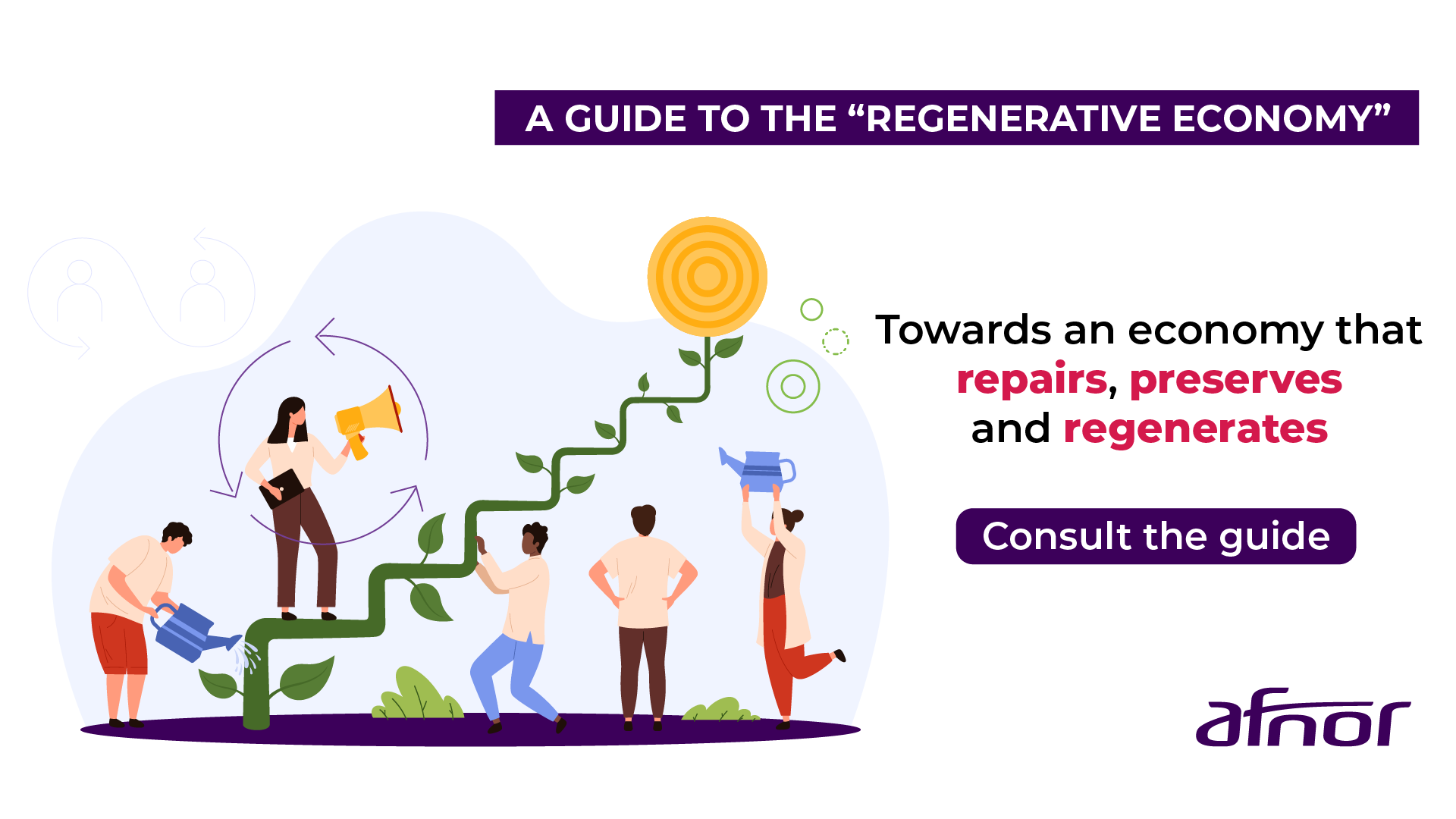The regenerative economy lays the cornerstone for standardization

” Look at the bee: it takes and it gives. In fact, all living things do the same… except human beings! We take, but we never give back. When I made this observation, it was a real wake-up call for me. “. Isabelle Delannoy, an agricultural engineer and president and co-founder of L’Entreprise symbiotique, has been campaigning for the regenerative economy for several years, training players and helping them set up pilot projects. So it’s hardly surprising to find her at the head of the working group that has just given birth to AFNOR Spec 2315 in the autumn of 2024. Around the table are some twenty players from all walks of life, including local authorities, universities and companies such as Axa Climate and the Pierre & Vacances Center Parcs group. The aim of the document is to share and disseminate a common definition of the regenerative economy, in the same way as the ISO standards for the circular economy , and to encourage executive committees to reflect on the issue, providing them with angles and ideas for action. The text recalls that six of the nine planetary limits that guarantee the world’s habitability, modeled in 2009, have been exceeded. The consequences are ecological, health, social, economic, political and geopolitical,” says the Spec.
The challenge is to switch to an economy powered by a different engine, one that, instead of destroying the planet’s equilibrium, helps to restore it and nourishes ecosystems and the principles that generate life. This engine exists: the regenerative economy. ”
A 3D economy
The regenerative economy is still in its infancy, and this first reference framework lays the foundations for aligning the players. For example, to be sustainable, ” the system must be capable of regenerating itself in its three dimensions: economic, ecological and social “. This may mean encouraging the de-artificialization of land, but also ” quality employment “, social ties and individual well-being (physical, physiological, mental), or the sharing of value. One example is the industrial start-up H2X , in Brittany, which specializes in the production of carbon-free hydrogen. The company’s approach is not to think solely in terms of production and distribution, but to start from the real needs of companies and local authorities: mobility, heating, lighting, production line operation, etc. Another initiative: Mob-Ion electric scooters (Origine France Garantie). Their modular design, based on components with no molded or glued parts, combined with a rental model – an economy of functionality – means that over 60% of parts can be directly reused, while the remaining parts can be optimally recycled. ” Thanks to all this, the model is over 70% independent of inflation, generates local jobs that cannot be relocated, avoids the ever-new extraction of the raw materials on which it depends, and helps preserve the natural ecosystems of the extraction permits ,” explains Mob-Ion. Textile companies are also involved in this revolution,” adds Catherine Dauriac, President of the NGO Fashion Revolution (French office).
Textiles, as we know, affect both natural resources and human rights, with problems of living wages, moral and sexual harassment in many countries. In France, there are already several specialized collectives. “She cites two examples from the field, that of two cooperatives, Virgocoop (hemp sector) and Laines paysannes. ” They show us how we can better take into account the specificity of a territory and act in concert to achieve a specific goal. Regenerating means using everything at our disposal to recreate new resources… without extracting again! “appreciates Catherine Dauriac.
Regenerative economy: 1+1 = 3
Mathieu Vérillaud, Head of Impact Measurement and Regenerative Business Models, describes how Axa Climate, through its consulting missions, training courses and insurance products, is trying to change lines within the Group and among its customers, while being very conscious of the fact that this is a long-term undertaking: “We are committed to a sustainable development policy. We have to accept that there is no finish line. It’s all about making continuous progress, and to do that we need to be able to agree on common ground, as this Spec makes possible. We also need to be able to cooperate: this notion of cooperation is key to the regenerative approach. Cooperation isn’t collaboration, it’s not limited to a project with a time limit. You’re working on a project that’s bigger than the two of you. 1+1 = 3! You’re involved in a project that’s bigger than both of you, and very often it’s territorial. ”
Christian Bruère, President of Mob-ion, insists on the accounting aspect. To anchor regenerative technology in reality, sooner or later we’ll have to move the accounting cursors. ” It’s difficult because we’re not looking for performance, we’re looking for robustness. But guess what happens? We realize that we’re actually very competitive! he says. The solution lies in accounting. Today, for example, you’re not allowed to depreciate a product over a period of more than twenty years. But since 2016, it has been possible to depreciate components on a component-by-component basis. And I believe that the twenty-year rule will soon come to an end. ”
And Isabelle Delannoy adds: ” After battery chickens, we invented battery companies: they’re there to produce euros! We support the systemization of ecological, economic and social performance, as it is the driving force behind a new, sustainable and resilient form of value creation. Tomorrow, we’ll need to equip it with a multi-capital accounting system that respects its specificity: the idea is not to transform everything into euros. The regenerative economy is highly effective because it makes us resilient to inflation and shortages of raw materials. “